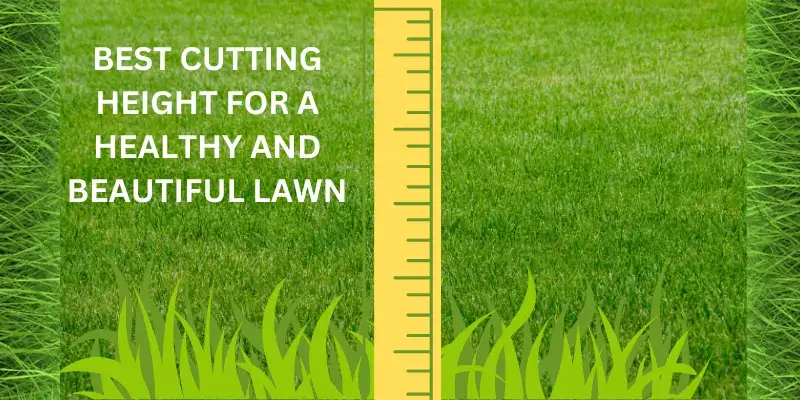Maintaining the Best Grass Cutting Height for a beautiful and healthy Lawn
When it comes to maintaining a healthy and beautiful lawn, one crucial aspect often overlooked is the proper height at which to cut the grass. Achieving the ideal grass height can have a significant impact on the overall health and aesthetics of your lawn. As I delve into this topic, I will try to explore the importance of maintaining the right grass height and how it plays a pivotal role in creating a lush and vibrant outdoor space that you can be proud of.
A well-manicured lawn not only adds curb appeal to your home but also provides a soothing and inviting environment for relaxation and enjoyment. The height at which you mow your grass directly influences its ability to thrive, ward off pests, and resist diseases. By understanding the significance of maintaining the optimal grass height, you can unlock the secret to a healthier and more visually appealing lawn.
BEST CUTTING HEIGHT FOR A BEAUTIFUL AND HEALTHY LAWN
I am starting a journey to discover the ideal grass-cutting height, explore its connection to a healthy and beautiful lawn, and discover practical Best cutting height for a healthy and beautiful lawn tips to achieve the perfect balance. Get ready to transform your yard into a breathtaking oasis that will leave your neighbors green with envy.
FACTORS INFLUENCING GRASS GROWTH:
Water:
Adequate and consistent watering is vital for healthy grass growth. Both conditions excessive water or insufficient water can hinder the growth of grass.
Sunlight:
Grass needs sunlight for photosynthesis. Insufficient light can slow growth, while too much can scorch some varieties.
Soil Quality:
Nutrient-rich soil fosters healthy grass. pH balance, aeration, and proper drainage impact growth significantly.
Temperature:
Different grass types flourish in varying temperature ranges. Extremes—either too hot or too cold—can stress or impede growth.
GRASS TYPES AND TRAITS:
Cool-Season Grasses:
Like Kentucky Bluegrass and Fescue, thrive in cooler climates and go dormant in summer heat.
Warm-Season Grasses:
Bermuda and Zoysia prefer warmer climates and may turn brown in colder months.
Blends and Mixes:
Combining grass types can offer a balance of traits, such as durability and aesthetics.
UNDERSTANDING THE IMPORTANCE OF GRASS HEIGHT – TO MAKE YOUR LAWN BEAUTIFUL AND COZY
A. Importance of Maintaining the Proper Grass Height:
Maintaining the proper grass height is essential for achieving a healthy and beautiful lawn. Understanding the concept of grass height and its impact on lawn health is crucial. Several factors come into play when determining the ideal grass height for your lawn. By considering these factors, you can ensure optimal growth.
B. Factors to Consider When Determining the Ideal Grass Height
The first factor to consider is the grass species and variety you have in your lawn. Different grass types have different growth habits and optimal heights. For example, Bermuda grass thrives at a lower cutting height, while Tall Fescue prefers a slightly higher cut. Understanding the specific requirements of your grass type will help you determine the appropriate cutting height of your lawn.
C. Climate and Environmental Conditions
Climate and environmental conditions also play a significant role in determining the ideal grass height. Areas with hot and dry climates may require slightly taller grass to provide shade and retain moisture. On the other hand, cooler regions may benefit from shorter grass to prevent moisture-related issues. Assessing the climate and environmental factors in your area will guide you in selecting the right cutting height.
D. Seasonal Variations
Lastly, seasonal variations should be considered when determining the grass height. Grass growth patterns change throughout the year, and adjusting the cutting height accordingly can promote healthy growth. For example, during the active growing season, you may want to maintain a higher cutting height to encourage root development and protect against heat stress. In colder months, a lower cutting height helps prevent snow mold and other winter-related issues.
By considering these factors – grass species, climate, and seasonal variations – you can determine the best grass height for your lawn. This attention to detail and understanding will contribute to a lush, vibrant, and healthy lawn that you can enjoy with your family and friends.
BEST CUTTING HEIGHT FOR DIFFERENT GRASS TYPES
Maintaining the proper cutting height for different grass types is key to achieving a healthy and beautiful lawn. The best cutting heights for various warm-season and cool-season grasses are explained in the below table:
| SEASON | Grass Type | Recommended Cutting Height | Benefits |
| Warm Season Grasses | Bermuda grass | 1 to 1.5 inches (2.5 to 3.8 cm) | Encourage dense growth, prevents weed invasion, promotes the lush appearance |
| Zoysia grass | 1.5 to 2.5 inches (3.8 to 6.4 cm) | Provides enough leaf surface for photosynthesis, improves drought tolerance | |
| St. Augustine grass | 2.5 to 4 inches (6.4 to 10.2 cm) | Promotes deep root development, enhances resilience against heat stress |
| SEASON | Grass Type | Recommended Cutting Height | Benefits |
| Cold Season Grasses | Kentucky bluegrass | 2.5 to 3.5 inches (6.4 to 8.9 cm) | Encourages dense, attractive appearance, helps prevent weed growth |
| Tall fescue | 3 to 4 inches (7.6 to 10.2 cm) | Promotes strong root development, increases drought tolerance, aids in weed suppression | |
| Fine fescue | 2 to 3 inches (5.1 to 7.6 cm) | Retains moisture, reduces the risk of disease, contributes to a healthy and attractive lawn |
By adhering to these recommended cutting heights for different grass types, you can ensure optimal growth, disease resistance, and a visually appealing lawn. Remember to adjust the cutting height based on seasonal variations and specific lawn conditions for the best results.
FREQUENTLY ASKED QUESTIONS (FAQs)
What Height Should I Cut My Grass for a Healthy Lawn?
Aim to cut your grass to about 3 inches tall to promote a healthy, robust lawn.
How High Should I Cut Grass in Spring?
In spring, keep your grass cut at a slightly lower height of about 2.5 inches to encourage growth.
Why Is Consistent Cutting Height Important?
Keeping a consistent cutting height prevents stress on the grass, ensuring a healthier lawn.
Is 4 inches a good height for grass?
Yes, 4 inches is ideal for promoting deep root growth, especially during the hot summer months.
Is 3 inches too tall for grass?
No, 3 inches is a perfect height for most types of grass, balancing health and appearance.
Is 2 inches too short to cut grass?
For most grass types, 2 inches can be too short, risking sun damage and weakening the grass.
What is the average height of grass?
The average height for a healthy lawn is around 3 inches, allowing for optimal health and resilience.
CONCLUSION
Maintaining the proper cutting height for your grass is crucial for a healthy and beautiful lawn. By understanding the importance of grass height and considering factors like grass species, climate, and seasonal variations, you can make informed decisions that promote optimal growth and overall lawn health. Each grass type has specific height requirements, so it is important to adhere to these recommendations to ensure your lawn receives the care it deserves.
Whether you have Bermuda grass, Zoysia grass, St. Augustine grass, Kentucky bluegrass, tall fescue, or fine fescue, knowing the ideal cutting heights for each type allows you to create a personalized maintenance plan. Remember to adjust the cutting height based on the season, as a higher height during active growing seasons encourages root development and protection against heat stress, while a lower height in colder months prevents winter-related issues. By considering these factors and following the recommended cutting heights, you can transform your yard into a stunning oasis that will impress your neighbors.
Start setting the best cutting height, and make your lawn healthy and beautiful so that your neighbors and close ones praise your efforts in maintaining your home yard. With the knowledge and practical tips shared in this blog, you can achieve a lush, vibrant, and inviting outdoor space that brings pride and joy to you and your family. Enjoy a lawn that not only enhances the curb appeal of your home but also provides a cozy and relaxing environment for you to unwind and appreciate the beauty of nature. By taking these steps, you will be well on your way to a stunning and envy-worthy yard.

About Naveed A Hashmi
In my childhood, I used to see my parents while working in the land, for these reasons today I have been serving the same as our own tradition and culture. I thus love to stay in it, because I want to learn something advanced and new so that I may improve my farm’s contour and help others with my experience.







